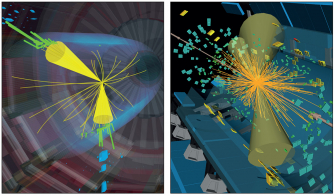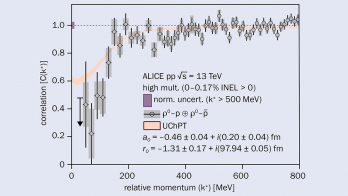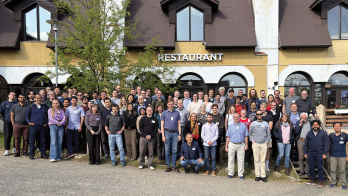Looking back 75 years to the first accelerator-based physics experiment.
In April 1932 John Cockcroft and Ernest Walton split the atom for the first time, at the Cavendish Laboratory in Cambridge in the UK. Only weeks earlier, James Chadwick, also in Cambridge, discovered the neutron. That same year, far away in California, Carl Anderson discovered the positron while working on cosmic rays. So 1932 was a veritable annus mirabilis in which experiments discovered, and worked with, nucleons; exploited Albert Einstein’s relativity and energy-mass equivalence principle; took advantage of the newly emerging quantum mechanics and its prediction of “tunnelling” through potential barriers; and even verified the existence of “antimatter” predicted by Paul Dirac’s relativistic quantum theory of the electron. It is hard to think of a more significant year in the annals of science.
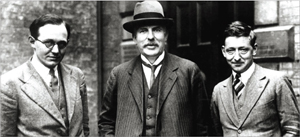
Image credit: AIP Emilio Segrè Visual Archives.
Ernest Rutherford (centre) encouraged Ernest Walton (left) and John Cockcroft (right) to build a high-voltage accelerator to split the atom. Their success marked the beginning of a new field of subatomic research.
Image credit: AIP Emilio Segrè Visual Archives. The experiment by Cockcroft and Walton split the nucleus at the heart of the atom with protons that were lower in energy than seemed possible, by virtue of quantum mechanical tunnelling – a phenomenon new to physics. In 1928 George Gamow had applied the new quantum mechanics to show how particles could tunnel through potential barriers, and how this could explain the decay of nuclei through alpha emission. He also realized that tunnelling could lower the energy required for an incident positively charged particle to overcome the Coulomb barrier of a target nucleus. It was this insight that underpinned the commitment of Cockcroft and Walton.
The entire sequence of events that led to the pioneering experiment (the specification of particle beam parameters based on contemporary theoretical application and phenomenology; the innovation and development of the necessary technologies to create such beams; and the use of the beams to do experiments on a subatomic scale to achieve a deeper understanding of the structure and function of matter) have been repeated many times as high-energy physics has advanced with the construction of accelerators to the current Standard Model of particles and forces. That Cockcroft realized the immense potential of accelerators in research, and in particular for progress in fundamental physics, is manifest in his instrumental role in later years to establish large accelerator laboratories, in particular CERN in 1954.
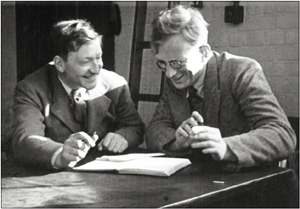
Image credit: AIP Emilio Segrè Visual Archives, Bainbridge Collection.
Cockcroft was born on 27 May 1897 to a family of cotton manufacturers in Todmorden, straddling the Lancashire–Yorkshire border in northern England. In his early years he experienced a varied educational background. He studied mathematics at Manchester University in 1914–1915, but the First World War interrupted his studies with service in the Royal Field Artillery. After the war, he returned instead to the College of Technology in Manchester to study electrical engineering. Later he joined the Metropolitan Vickers (“Metrovick”) Electrical Company as an apprentice for two years, but subsequently went to St John’s College, Cambridge, and took the Mathematical Tripos in 1924. This wide-ranging education served him well in later years. Nowadays, modern accelerator science and engineering relies on such a broad application of skill and innovation.
Such a diverse and formidable combination of training in mathematics, physics and engineering, plus practical experience with a local electrical company, primed Cockcroft for his future success. He joined Ernest Rutherford, who had recently moved from Manchester to the Cavendish Laboratory and with whom he had worked as an apprentice back in Manchester. Initially Cockcroft worked with Peter Kapitsa in the high-magnetic-field laboratory, where he used his industrial links to obtain the necessary large-scale equipment.
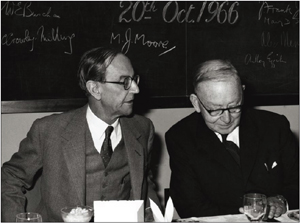
Image credit: AIP Emilio Segrè Visual Archives, Kowarski Collection.
At the time, Cockcroft was in many ways the Cavendish Laboratory’s only true “theoretician”, bringing his mathematical abilities as well as his pragmatic engineering skills to a group that was strong in the experimentalist tradition of Rutherford. Cockcroft realized in 1928, before anyone else, the implications of Gamow’s tunnelling theory, namely that an energy of 300 keV might be sufficient for protons to penetrate a nucleus of boron, and even less for lithium. In a seminar at the Cavendish Laboratory in 1928 the young Soviet physicist Georgij Gamov (who became better known as George Gamow) reported on his calculations of potential-barrier tunnelling, its successful application to alpha-decay, and its importance for barrier penetration. Encouraged by Rutherford, Cockcroft initiated the high-voltage accelerator programme, and was joined by a student, Ernest T S Walton from Ireland.
Walton was a Methodist minister’s son, born in 1903 and educated in Belfast and Dublin. He was very much the lead experimentalist, though the junior partner. The aim was to build an accelerator to achieve an energy up to 1 MeV in order to be sure to penetrate the nuclear potential barrier. Walton had abandoned work on a circular accelerator for his thesis topic and now pursued the linear solution with Cockcroft. They took advantage of strong links with Cockcroft’s old employer in Manchester, Metrovick, which at the time was pioneering equipment for the UK electrical grid at transmission voltages up to 130 kV. Metrovick supplied the high-voltage transformers for what became the Cockcroft–Walton generator. So even at the start of the nuclear age, academic–industrial collaboration underpinned progress.
There were formidable challenges to overcome in each component: motor, generator and transformer; rectifier; 40 kV proton source; glass vacuum vessel; and so on. To this day working with such voltages, even below 500 kV, causes difficulties, as witnessed by the performance issues faced in DC photo-injectors at Jefferson Laboratory and Daresbury Laboratory. The interesting story of scrounging for the proper ceramic tubes to be used in the ultimate Cockcroft–Walton generator is a saga in itself.
Records show that life at the Cavendish Laboratory under Rutherford did not begin early in the day and finished strictly at 6.00 p.m. Rutherford insisted that it was to preserve health and to aid contemplation. Perhaps it partly explains the relatively slow progress by Cockcroft and Walton between 1929 and the ultimate triumph in 1932, although perhaps also it was, by all accounts and like all experimentalists, because both enjoyed the fun of building and perfecting their new experimental “toy”. Another reason was the relocation of their laboratory and a rebuild of their apparatus to a nominal 800 keV rating, primarily because of their own lack of confidence in the predictions of the new tunnelling calculations.
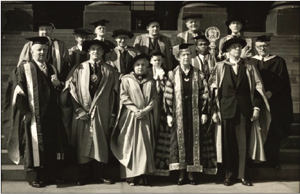
Image credit: J Dainton.
The day that transformed subatomic physics was 14 April 1932 when Cockcroft and Walton split the lithium atom with a proton beam. Accounts have it that Rutherford had become frustrated at the lack of results from the generator, which was Cockcroft and Walton’s pride and joy, and insisted that they get some results. Initially they used a beam of 280 keV, but later demonstrated atom splitting by a beam with energy below 150 keV. The experimenters closeted themselves in a lead-lined wooden hut in the accelerator room, and then peered through a microscope to look for scintillations due to alpha particles, which they counted by hand. If a zinc sulphide screen hanging on the wall glowed, they added a little more lead – so much for health and safety 75 years ago. Of course, they found scintillations, thereby observing the splitting of lithium nuclei by the incident protons, to form two alpha particles.
Ironically, as Gamow’s idea of barrier penetration proved to be correct, the experiment could have been performed at least a year earlier in a previous version of the apparatus. This is also true of a successful experiment in October 1932 at the Kharkov Institute, Ukraine, and for Ernest Lawrence’s cyclotron in Berkeley, California, soon after Cockcroft and Walton’s results. (In early August 1931, Gamow, and later Cockcroft, had visited the Kharkov Institute and discussed the new idea.) Many laboratories repeated and added to the work of the Cavendish Laboratory during the following six months, leading to a flood of experiments around the world. But it was Cockcroft and Walton who first split the atom, albeit later than might have been.
The so-called Cockcroft–Walton multiplier, based on a ladder-cascade principle to build up the voltage level by switching charge through a series of capacitances, is still in use today. Only in 2005, for example, was the version used on the injector for ISIS, the spallation neutron source at the Rutherford Appleton Laboratory, replaced by a new 665 keV RF quadrupole. The old multiplier will soon be on display at the entrance to the UK’s newly created Cockcroft Institute of Accelerator Science and Technology in Cheshire. The original version used by Cockcroft and Walton was, in fact, a refinement of a much earlier circuit by M Schenkel, a German engineer, which Heinrich Greinacher had already improved and so could never be patented.

Image Credit: S Eyres/Daresbury Lab Media Services.
Cockcroft and Walton naturally had close links with Chadwick, whose Nobel prize-winning discovery of the neutron occurred only a few weeks earlier in the same laboratory, making 1932 an extra-ordinary year for an extraordinary laboratory. Chadwick eventually built the first synchrocyclotron at the University of Liverpool, which was then reproduced at CERN at its inception in the early 1950s.
Cockcroft took over the Magnet Laboratory in Cambridge in 1934 following the departure of Kapitsa, and Walton moved to Trinity College, Dublin. In 1939, Cockcroft started work on radar systems for defence. In 1944 he became director of the Chalk River Laboratory, Canada. Two years later he was back in the UK, where he was appointed inaugural director of the Atomic Energy Research Establishment (AERE), Harwell, and played a major leader-ship role in ensuring the eventual operation of the world’s first nuclear power station at Windscale. He was also influential with the newly founded Indian government, whose foreign diplomat Vijayalakshmi Pandit visited Cockcroft in the UK for advice on the creation of an atomic-energy enterprise in India under physicist Homi J Bhabha’s leadership and initiative.
The week of 8–12 October 2007 marked the 50th anniversary of an event that was as notorious in its day as Three Mile Island in Pennsylvania or Chernobyl: the fire in the reactor at Wind-scale on the coast in north-western England. This was an environmental disaster that followed a standard procedure to release Wigner (thermal) energy stored in the graphite pile. The cause is still controversial. However, it would have been much worse without a feature widely known as “Cockcroft’s folly”, which was added late in the construction of the reactor. Cockcroft was head of AERE at the time and he intervened to insist on filters on the chimneys, which were retrofitted and were therefore at the top, so giving the chimneys their distinctive shape with large concrete bulges. Cockcroft’s intervention undoubtedly saved a much bigger disaster.
Cockcroft took charge of the AERE at a time when it was almost the sole repository of particle-accelerator expertise in Europe. In addition to early linear-accelerator construction, there was pioneering work on what was then a new and exciting device, the synchro-tron. Several small 30 MeV rings were built and larger ones designed for universities at Oxford, Glasgow and Birmingham. Then when planning started for CERN – which was not greeted with much enthusiasm by some in the UK who already had their own machines – it was Cockcroft who appointed Frank Goward from Harwell to assist Odd Dahl and Kjell Johnsen in the design of the PS. Soon afterwards he also encouraged two other important figures from Harwell to join in, with lasting impact on CERN: Donald Fry and John Adams.
In 1951, Cockcroft and Walton shared the Nobel Prize in Physics for the “transmutation of atomic nuclei by artificially accelerated particles”. Why had it taken so long to recognize the achievement, when Lawrence was instantly rewarded in 1932 for the invention of the cyclotron? The reason seems to be that there was a long list of giants still waiting to be recognized – Heisenberg among them – before Cockcroft and Walton could take their proper place. The awarding of the Nobel prize to Lawrence for the cyclotron helped to establish the pattern of rewarding instrument building for its own sake, introducing “innovation” into the criteria of the Nobel committee, in addition to “discovery”.
Cockcroft later held many important and influential scientific and administrative positions. He was president of the UK Institute of Physics and the British Association for the Advancement of Science, and was chancellor of the Australian National Academy, Canberra. His work was also acknowledged in many ways, including honorary doctorates and membership of many scientific academies. In 1959 he was appointed master of Churchill College, Cambridge. He died, aged 70, on 18 September 1967 – a year after the celebration of Chadwick’s 75th birthday at the newly created Daresbury Laboratory. It is at Daresbury that another important step forward for accelerator physics has begun, with the Cockcroft Institute named in honour of the accelerator “giant” who, along with Walton, first split the atom 75 years ago.






